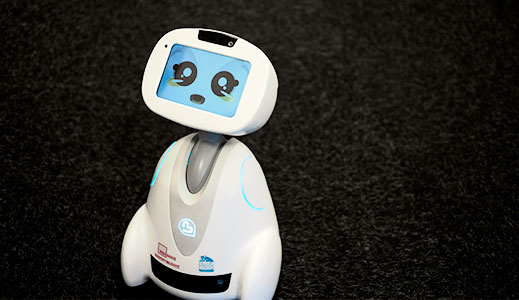Don’t Expect Too Much from This Robot, Buddy
I couldn’t help feeling sorry for Buddy the robot when it visited our offices this week. It seemed a little hard of hearing, forgetful, and generally baffled by what was going on.

Buddy is a robot companion and home helper being developed by a company called Blue Frog Robotics, based in Paris, and several executives are touring the U.S. demonstrating a prototype.
The little white robot is cute enough, attracting a crowd of curious admirers and craning its neck around from the floor as people try to talk to it. But it hardly seems very useful. Buddy could perform a few tricks, like introducing itself, describing the local weather, and doing a little dance. But it kept mishearing commands, and it was entirely unable to strike up a meaningful conversation. As the executives repeatedly shouted “Dance, Buddy,” the robot’s face just rotated through a series of odd expressions, and it kept repeating the sad, confused phrase “I’m tired to talk.”
After asking Buddy a few questions, I felt a little tired to talk, too. Perhaps the robot was just exhausted by the whole experience. It was just a prototype, after all. And maybe the finished version will be far more polished, and maybe developers will quickly build some impressive new apps.
But Buddy’s shortcomings do seem to illustrate a gap between expectations and reality building up around domestic robots. The promotional video created for a crowdfunding campaign used to raise money for Buddy’s development, for example, promises something extremely sophisticated and intelligent: a robot capable of roaming the house, conversing with people naturally, and assisting thoughtfully with chores.
In truth, before anything like that can become a reality, progress needs to be made in natural language processing, machine vision, and human-computer interaction. For example, Buddy does come with facial recognition software, but it has trouble working from such a low angle, with lights glaring behind people’s heads.
I don’t mean to be too hard on Buddy or his creators. For the expected price tag ($749), Blue Frog Robotics has put together something relatively sophisticated. The hardware consists of a touch-screen tablet connected to cameras, and ultrasound and thermal cameras. The finished version will include a 3-D mapping sensor from Intel. The developers are also taking a smart approach by building Buddy’s interface with Unity, a common software platform used for games, and by making it easy for developers to build apps for the robot.
But all that doesn’t add up to a proper robot helper. So while it was nice to see you, Buddy, I’m not going to invite you into my home just yet.
Deep Dive
Artificial intelligence
Large language models can do jaw-dropping things. But nobody knows exactly why.
And that's a problem. Figuring it out is one of the biggest scientific puzzles of our time and a crucial step towards controlling more powerful future models.
Google DeepMind’s new generative model makes Super Mario–like games from scratch
Genie learns how to control games by watching hours and hours of video. It could help train next-gen robots too.
What’s next for generative video
OpenAI's Sora has raised the bar for AI moviemaking. Here are four things to bear in mind as we wrap our heads around what's coming.
Stay connected
Get the latest updates from
MIT Technology Review
Discover special offers, top stories, upcoming events, and more.